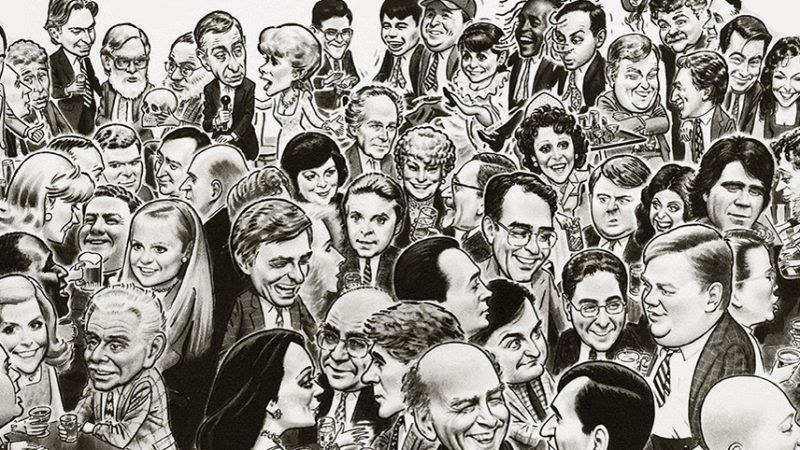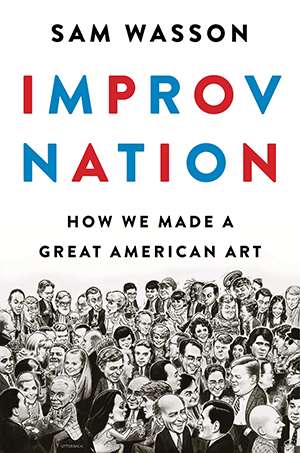Improv Isn't Totally Terrible
But it's not "a great American art."

Improv Nation: How We Made a Great American Art, by Sam Wasson, Eamon Dolan/Houghton Mifflin Harcourt, 464 pages, $28

It wasn't originally supposed to be funny. But improv has taken over comedy and, according to Sam Wasson's lively book Improv Nation, become "a great American art." Can he make the case?
I hate to give away the punchline, but no, he can't.
The story starts with Viola Spolin around 1940. Yes, there was improv before Spolin—actors have been improvising in character at least since the days of commedia dell'arte—but Wasson is referring to the modern American brand of improv.
Spolin worked at Hull House, a community center serving Chicago's poor immigrants. She taught the children there to play onstage; the idea was to foster self-expression. Spolin developed her techniques and spread them to other venues. Her son, Paul Sills, watched the process and felt improv could be used to bond people in ways traditional theater couldn't. In 1955, he helped found the Chicago-based Compass Players, the first improvisational theater in the United States.
Sills and his cast, which included Mike Nichols, Elaine May, and Shelley Berman, fumbled their way to surprising discoveries. For one thing, you don't go for laughs; you go for honesty and reality, and the laughs will come. (A more fundamental discovery was that they got laughs in the first place.) The basic rule of improv, identified along the way, was to not deny your partner's reality but instead add to it.
Nichols and May left the troupe and became huge stars. In a world where comedy was often defined by Borscht Belt entertainers telling prepackaged jokes, they were a revelation. Watching them make up routines on the spot was stunning. And their sketches—horny teenagers groping their way toward ecstasy, a nagging mother reducing her rocket scientist son to infancy—brought a sort of knowing wit, immediacy, and truthfulness that was rare at the time. It was the gift this new style of comedy had to offer.
At this point in the book, alas, it becomes evident that Wasson has bitten off more than he can chew. His previous work, such as his fine biography of Bob Fosse, largely stuck to one artist. Here his tale spans three generations and features a cast of hundreds.
We see improv start with Chicago intellectuals conversant in philosophy and literature, spread to a new generation that grew up on TV, and then reach an age group that had watched the previous cohort making it in show biz. We watch the Compass Players morph into Second City—still the Mecca for improv today—and inspire a host of other troupes: The Premise and The Committee and The Groundlings and ImprovOlympic and the Upright Citizens Brigade. We see improv leave the stage as its techniques are adapted to TV (Saturday Night Live, SCTV) and movies (The Graduate, Stripes, This Is Spinal Tap, Waiting for Guffman, Anchorman, The 40-Year-Old Virgin).
In a book with fewer than 400 pages of text, this means we get only an impressionistic view of the growth of improv, flashes of a much larger story. Throughout the journey Wasson returns to certain people, giving us glimpses of their lives when many of them deserve books of their own.
We meet Alan Arkin, a trained actor who didn't take to improv, finally finding himself when he started playing people on the fringe. Fred Willard, who specialized in characters with no self-awareness. John Belushi, a force of nature so powerful he was the only person to go straight from auditions to the main company at Second City. Bill Murray, a man completely open to experience who could turn on you in a second. Gilda Radner, so lovable that even when she failed onstage she didn't really fail. Chris Farley, who performed slapstick with such abandon that people feared for his safety. Stephen Colbert, who initially avoided political material because he felt it was mean-spirited and just told the audience what it already believed.
We're also taken backstage at the creation of magical moments. Mike Nichols getting a call from his mother, which he and Elaine May spin into comedy gold. Howard Hesseman, so angry at LBJ that he wants to kick in his TV, converting that feeling into an odyssey of murderous hatred and joyous love involving the whole audience. Andrea Martin hastily grabbing a costume off the rack and immediately transmuting into the classic character Edith Prickley. Bob Odenkirk turning the uninhibited Chris Farley into Matt Foley, motivational speaker, who lives "in a van down by the river." Adam McKay, who felt improv was getting too safe, convincing Scott Adsit to persuade a Second City audience that Bill Clinton had been assassinated.
No author has ever put it all in one place like this, or told it as well (though an oral history of Second City published 40 years ago, Something Wonderful Right Away, comes close). But for all the attention the book gives to the wide world of improv, it can't quite live up to Wasson's subtitle, How We Made a Great American Art.
In his introduction, Wasson claims that "the deepest, most explosive laugh, the painful, blinding gasping for breath that has you physically bracing yourself on something solid so you don't fall over, is the laugh that erupts from the spontaneous materials of real time, in real life."
Hmm. I've seen quite a bit of live improv, even participated in it. When it's done poorly, which is often, it's excruciating. But even at its best, it still usually isn't much. Improv is like Samuel Johnson's line about a dog walking on its hind legs: It's not that it's done well, but that it's done at all. You're seeing something created right before your eyes. It may not be deep or penetrating or all that clever when looked at from the long view, but you're so impressed that it's happening this very second that you'll forgive almost anything.
Think of Nichols and May, the best there ever was. Every night they'd create a scene in a style suggested by the audience: Chekhov, Tennessee Williams, Wilde, O'Neill, whomever. As creative as they were, it could never be as good as the real thing. A tightrope act can be thrilling, but it's still a stunt.
Everyone knows they're supposed to love improv (and hate mime). The truth is, if you didn't know it was being made up on the spot but believed it was written, you'd probably think it was horrible.
Wasson gives away the game in his epilogue, where he takes us up to the present, attending a show at the Upright Citizens Brigade's outpost in Los Angeles. He calls it "one of the sincerest, funniest, most painfully raw and exuberant nights I've ever had in an improv theater." It turns out to be two civilians who've been matched up on a dating website having their date in front of an audience. If this is Wasson's idea of great art, I'd love to hear what he thinks of The Bachelor.
Not that improv doesn't have its place. It's a fine way to develop sketches—which is how it's been used at Second City and elsewhere for decades. It can be used in developing longer works, too. It's like writing: You don't get it right the first draft, but you keep going at it, changing this line, cutting that one, trying a different approach till you've got something.
Improv can also help an actor develop. It teaches you to listen, to be in the moment, and to stay true to character.
But even in something as purely improvisational as Waiting for Guffman—the Christopher Guest film where each moment except the musical numbers was improvised—there's still a lot of structure imposed behind the scenes to make it work. As Wasson recounts, Guest and Eugene Levy took a few weeks preparing the basic scenario. The cast then figured out their characters and how they'd react within the story. Guest ended up with 58 hours of material from which to carve out an 84-minute feature. Editing took 18 months.
In other words, for all improv can do, what it can't do is replace well-prepared, thought-out material. In fact, improv has arguably had a deleterious effect on comedy in recent years. When actors are making up a lot of their lines and directors are shooting a lot of scenes to give themselves more choices, it can lead to slack dialogue and sloppy plots. A sense of spontaneity is fine (and can be achieved through different methods), but there's something to be said for sculpted dialogue and a plot that clicks into place—something you can still witness in many classic Hollywood comedies but that seems to be less common today.
So by all means, check out Sam Wasson's Improv Nation. It's the best book on the subject. Just don't believe everything he says.
This article originally appeared in print under the headline "Improv Isn't Totally Terrible."



Show Comments (85)